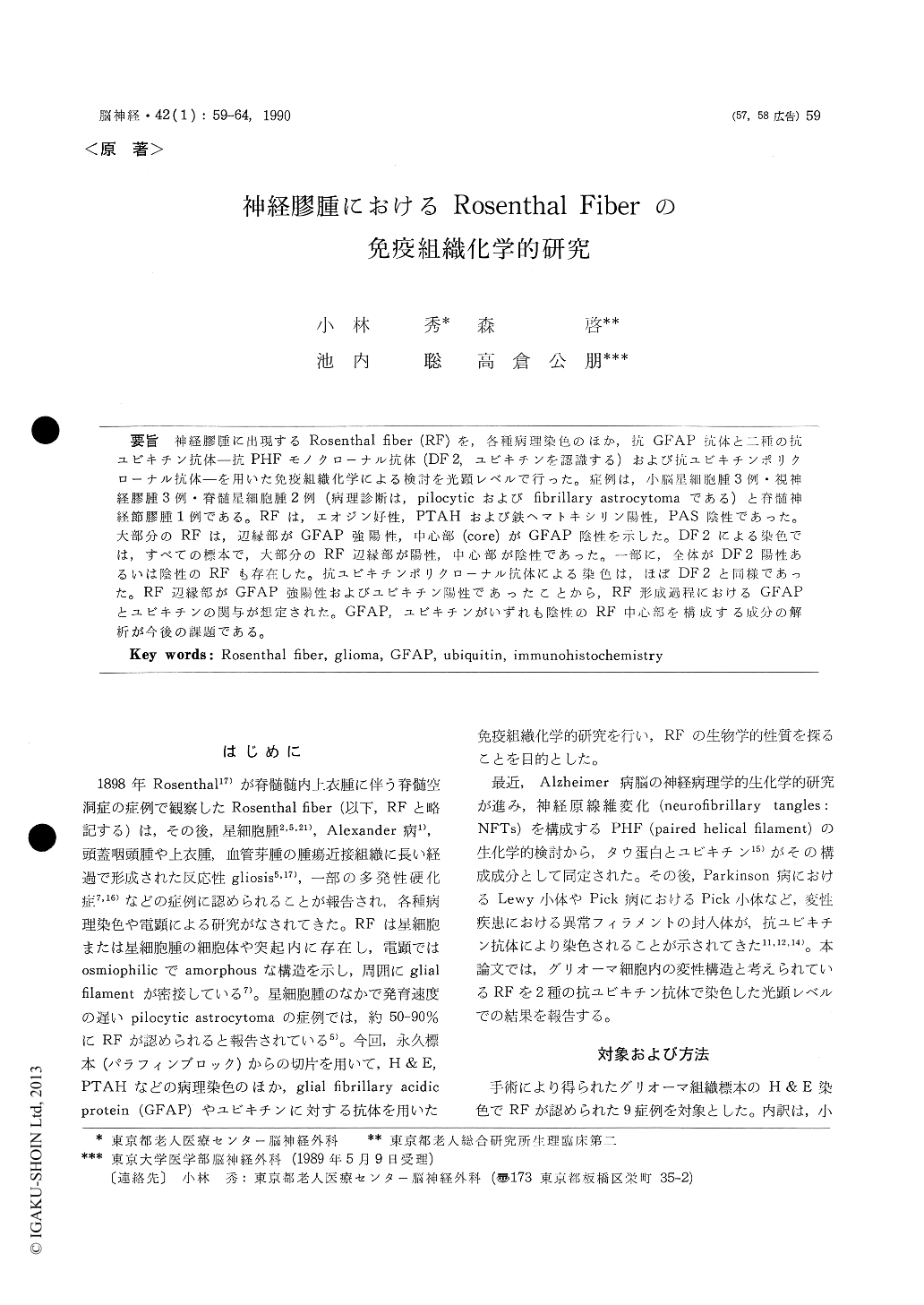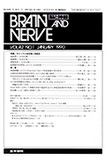Japanese
English
- 有料閲覧
- Abstract 文献概要
- 1ページ目 Look Inside
神経膠腫に出現するRosenthal fiber(RF)を,各種病理染色のほか,抗GFAP抗体と二種の抗ユビキチン抗体—抗PHFモノクローナル抗体(DF2,ユビキチンを認識する)および抗ユビキチンポリクローナル抗体—を用いた免疫組織化学による検討を光顕レベルで行った。症例は,小脳星組胞腫3例・視神経膠腫3例・脊髄星細胞腫2例(病理診断は,pilocyticおよびfibrillary astrocytomaである)と脊髄神経節膠腫1例である。RFは,エオジン好性,PTAHおよび鉄ヘマトキシリン陽性,PAS陰性であった。大部分のRFは,辺縁部がGFAP強陽性,中心部(core)がGFAP陰性を示した。DF2による染色では,すべての標本で,大部分のRF辺縁部が陽性,中心部が陰性であった。一部に,全体がDF2陽性あるいは陰性のRFも存在した。抗ユビキチンポリクローナル抗体による染色は,ほぼDF2と同様であった。RF辺縁部がGFAP強陽性およびユビキチン陽性であったことから,RF形成過程におけるGFAPとユビキチンの関与が想定された。GFAP,ユビキチンがいずれも陰性のRF中心部を構成する成分の解析が今後の課題である。
Immunohistochemically we investigated Rosent-hal fibers (RFs) on specimen surgically removed from patients with glioma (three cerebellar ast-rocytomas, three optic gliomas, two spinal cord astrocytomas, one spinal ganglioglioma). Patholo-gical diagnoses were pilocytic astrocytoma, fibril-lary astrocytoma, and ganglioglima. We utilized sections from the formalin-fixed paraffin-embedded tissues and stained them with H “ E, PTAH, PAS as well as with anti-GFAP (glial fibrillary acidic protein) antibody (Ab) and two anti-ubiquitin Abs… anti-PHF (paired helical filament) monoclo-nal Ab (DF 2) which recognizes ubiquitin (H. Mo-ri in Science) and anti-ubiquitin polyclonal Abprovided by Dr. Haas. The primary antibodies were diluted with Tris-saline as follows : anti-GFAP (1 : 500), DF 2 (culture medium without dilution), anti-ubiquitin (2 μg/ml). Sections were deparaffinized and incubated with primaty antibo-dies overnight at room temperature. They were visualized by the avidin-biotin-peroxidase complex (ABC) procedure (Vectastain, Vector, USA) and counterstained with hematoxylin. Negative control sections were treated by omitting the primary antibodies. In the representative specimen we com-pared H ” E, anti-GFAP and anti-ubiquitin stai-ning on 3 μm serial sections.
RFs were eosinophilic (bright red on H “ E), purply-stained with PTAH (metachromasia), black with Heidemhein's iron-hematoxylin, and negative with PAS. Anti-GFAP Ab stained glial filaments diffusely in the cytoplasm and cell process of astrocytomas in every case. The peripheral parts of most RFs were intensely stained with anti-GFAP. The whole part of some RFs showed dark staining, and no part of a few RFs showed posi-tive reactivity. DF 2 showed intense staining onthe ring around negative central core of most RFs in every specimen. The whole part was positive to DF 2 in few RFs, or negative in a few RFs. Anti-ubiquitin polyclonal Ab gave the similar re-sults as DF 2. From the study on the serial sec-tions, the peripheral halo of RFs was positive with both anti-GFAP and anti-ubiquitin Abs. The halo was identified as light-red ring around tha bright-red core of RFs on H ” E. The ring was orange-colored on PTAH.
Both GFAP and ubiquitin were considered to exist in the periphery of RFs and they might play an important role to constitute the amorphous core of RFs. Inclusion bodies in neurodegenerative dise-ases such as neurofibrillary tangles in Alzheimer's disease, Lewy bodies and Pick bodies were repor-ted to contain ubiquitin immunohistochemically and/or biochemically. To make clear constituents of the amorphous core of RFs and to elucidate the mechanism which induces RFs formation would contribute to understand the pathogenesis of seve-ral CNS diseases with inclusion bodies.

Copyright © 1990, Igaku-Shoin Ltd. All rights reserved.


